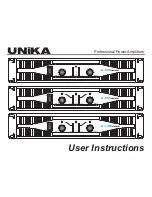
Quad Amp Hardware Reference Manual
Introduction
1
INTRODUCTION
The Delta Tau Data Systems, Inc. 4-axis Digital Amplifier (Quad Amp) is a highly compact digital
amplifier and power supply, packaged together to provide four axes of bi-directional (four quadrant)
torque control for a variety of AC or DC brushless or AC induction motors. All control parameters
including switching frequency and dead time are determined by software set-up of the controller, not in
the amplifier.
The Quad Amp is designed to work in conjunction with the Delta Tau PMAC2 motion controller, which
supports up to eight axes of motion control. The PMAC2 delivers Pulse Width Modulated (PWM) on/off
signals to the Quad Amp power transistors. The Quad Amp simply isolates and level-shifts these signals,
at the required frequency and magnitude, to obtain the desired torque, velocity, and position.
All feedback is processed by the PMAC2. The Quad Amp measures motor phase currents, digitizes them,
and transmits them back to PMAC2 as a serial data stream. Position feedback data is sent directly back to
the PMAC2 via the Acc-8F Digital Interface Board. The Quad Amp does not use or require any position
data.
Related Technical Documentation
The following technical manuals are required to successfully install and operate the Delta Tau Quad Amp.
These manuals should be included in the technical documentation package received with the Quad Amp.
If any of these manuals are missing, contact Delta Tau before attempting installation.
Manual Number
Manual Title
3A0-602204-363
PMAC User Manual and Software Reference with PMAC2 Addendum
3A0-602775-363
Acc-8F Digital Interface Board User Manual
3A0-602598-363
PMAC2 PC and PMAC2 Lite Hardware Reference Manual
3A0-602413-363
PMAC2 VME Hardware Reference Manual
3A0-602643-363
PMAC2 VME Ultralite Hardware Reference Manual
Safety Summary
The following are general safety precautions not related to any specific procedures and therefore may not
appear elsewhere in this publication. These are recommended precautions that personnel must
understand, apply, and adhere to during the phases of installation, operation, and maintenance.
Keep Away from Live Circuits
Do not replace components or make adjustments inside equipment with power applied. Under certain
conditions, dangerous potentials may exist when power has been turned off due to charges retained by
capacitors. To avoid casualties, always remove power and allow 10 to 12 minutes for the bus capacitors
to discharge before removing the cover.
Live Circuit Contact Procedures
Never attempt to remove a person from a live circuit with bare hands. To do so is to risk sure and sudden
death. If a person is connected to a live circuit, the following steps should be taken:
•
Call for help immediately
•
De-energize the circuit, if possible.
•
Use wooden or fiberglass hot stick to pull the person free of the circuit.
•
Apply cardiopulmonary resuscitation (CPR) if the person has stopped breathing or is in cardiac arrest.
•
Obtain immediate medical assistance.






































